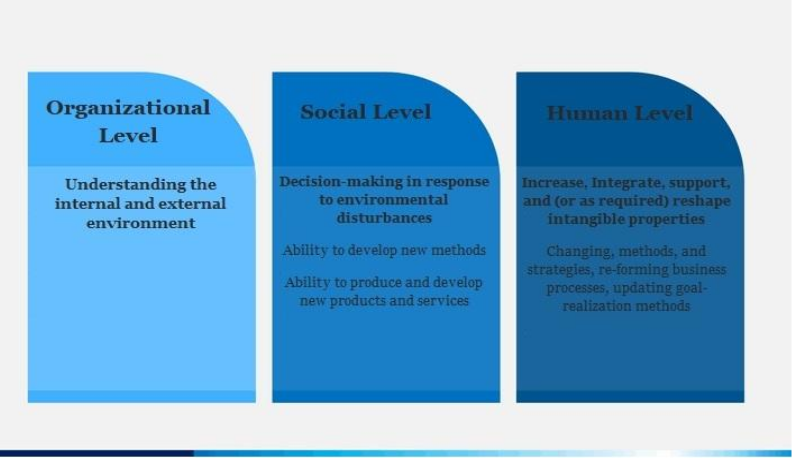By Mostafa Sayyadi and Michael J. Provitera
This article is a guide for executives looking to develop a more dynamic approach for their companies. This article starts by exploring organizational capital, including human, social, and organizational. Subsequently, a new model is presented to better manage organizational intangible assets. The proposed model assists in creating a competitive advantage from an intangible perspective.
The success and growth of any organization must rely on its people. [1] [2] [3] [4] [5] Hiring them, training them, and retaining them. Talent management is important for the success of any organization. Financial prowess and operational capabilities cannot guarantee success.
Competitive advantage is not sustainable unless the intangible items found on the balance sheet are managed and adhered to. [6] [7] Many organizations are too focused on the environmental factors and conditions governing the industry in which they compete. The ability to respond to the environmental conditions that exist in the marketplace is important, but this is minimal when considering the intangible concerns that are more important to the success of the organization. The perspective of internal factors considers the factors within the organization to be effective in gaining a competitive advantage, among which are two prominent perspectives: the resource-based approach and the dynamic capabilities approach.
According to the resource-based approach, valuable, rare, inimitable, and non-substitutable resources are the source of competitive advantage. [8] The resource-based approach is based on the principle that all resources of the organization are heterogeneous. The resource-based approach shows how some organizations are able to earn extraordinary and sustainable profits. However, the resource-based view has limitations.
The first serious conceptualizations regarding the theory of dynamic capability were presented by Teece and Pisano. Based on this theory, the resource-based approach is unable to answer some questions; including explaining how some successful companies can respond to environmental changes in time, perform product innovation quickly and flexibly, and have the management ability to coordinate and expand the internal and external competencies of the company.
The framework of the dynamic capabilities approach has a stronger position against competitive forces. According to its main definition of Teece, dynamic capability is the organization’s ability to integrate, create, and reformulate internal and external capabilities to face rapid environmental changes.
Our consulting experience says that many companies operating in a turbulent environment cannot be successful only by having operational capabilities. Although the capabilities and organizational routines as a result of repetitive activities may appear to satisfy short-term profitability, in the long-term, companies will be challenged and may not be as competitive as their rivals. Over time, the solutions that were somehow successful in different competitive conditions in the short run lose their main functionality. Thus, the dynamic capability approach may help organizations perform dynamically and sustain a competitive business environment.
The Proposed Model
Understanding the surrounding environment, the opportunities, the threats, and taking advantage of business opportunities is not anything new. However, we find that many companies are not using the intangible milestones that will provide revenue. The important dimension of the theory of dynamic capabilities adds value to the organizational revenue but it is not as clean-cut as other more formidable core competencies. The influencing factors (organizational capital, social capital, and human capital) provide opportunity and can be a primary competitive advantage. The theory of dynamic capabilities must be implemented well to affect financial performance.
-
Human capital and dynamic capabilities
In competitive advantage, the margins are shrinking if you do not have superior value to develop. [9] [10] [11] When you have a superior competitive advantage that is hard to copy, you can use your human capital which is hard to emulate by competition. Human capital is an organizational capital that contributes to core capabilities. This intangible asset gives you the human element within an organization. The human capital capabilities include the collective experience of the workforce, their prior learning, and their ability to continuously learn and grow. This issue depends on having knowledge, motivation, skill, experience, and possible judgments of people. In fact, the knowledge of people and their experiences is like a stimulus in the accumulation and use of knowledge. Companies that have higher levels of experienced and skilled employees identify changes faster, create knowledge, and use it to develop a variety of dynamic capabilities and react to potential opportunities and threats.
-
Social capital and dynamic capabilities
A second intangible competitive advantage is social capital. Alignment experience enables the organization to acquire information from new opportunities and create new processes from new knowledge and expertise that will increase its organizational capabilities. This means that network relationships are effective in processes and routines that play an important role in acquiring and integrating resources. Social capital is like a mechanism to understand the potential effects of knowledge on dynamic capability. Network learning enhances reconfiguration. High levels of social capital increase the organization’s ability to learn, integrate, and reconfigure organizational communication, manage alignments, and develop dynamic capabilities.
-
Organizational capital and dynamic capabilities
A third intangible competitive advantage component is organizational capital. Organizational capital is defined as institutionalized knowledge and experience that is stored in systems, databases, instructions, structures, routines, patents, and the like. [12] [13] Organizational structure and processes are like a formulated mechanism for learning, benefiting, sharing, and using organizational resources that increase the company’s capabilities. Codified knowledge allows organizations to strengthen their technical knowledge and helps develop innovative capabilities. Organizational processes and information technology increase the accumulation of knowledge and its use in an organized manner and are a prerequisite for dynamic capabilities. Organizational capital promotes a positive culture and is a continuous factor for learning and encouraging people to acquire new knowledge and facilitate a favorable environment that increases the organization’s ability to create knowledge and value.
The human resource management of an organization offers a learning organization that may compete based upon a faster and better learning experience. This offers an organization a team of professionals that encompass human capital, social capital, and organizational capital. This type of scenario is hard to imitate by competitors and hard to copy. Thus, a sustainable competitive advantage offers primary attention and perception of the environments that are accompanied by rapid changes, and this is vital the managers who are placed in positions of innovation have this ability while being able to reason these changes well. Thomas Edison created new ideas with a rapid approach as one of the greatest innovative geniuses. Human resource managers can easily manage these relationships, by offering an array of skilled managers and a workforce with the capacity to combine and integrate.
Figure 1: Human Resource Management Model of Intangible Competitive Advantage

In Conclusion
This article presents a comprehensive model of the competitive advantage from an intangible perspective. Human resource management can be used in the strategic process to create a product or service that cannot be imitated because perfecting intangible assets is hard to imitate. This construct is presented in our model as a foundation of the dynamic capabilities of a company. Patents and governmental subsidies help an organization keep its products from being copied, but when they expire or come to an end, the product or service can be easily copied or reverse-engineered. On the other hand, the more difficult products and services are to imitate due to the implementation of this model including organizational processes that are the intangible asset opportunities. The intangible processes are in some cases better than the more traditional product and service competitive advantage. A process innovation in the way we deliver superior service may help an organization sustain a competitive advantage. Hence, this article builds upon the aspects of a more dynamic organization that can provide both tangible and intangible processes in today’s highly competitive business environment.
About the Authors
 Mostafa Sayyadi works with senior business leaders to effectively develop innovation in companies and helps companies—from start-ups to the Fortune 100—succeed by improving the effectiveness of their leaders.
Mostafa Sayyadi works with senior business leaders to effectively develop innovation in companies and helps companies—from start-ups to the Fortune 100—succeed by improving the effectiveness of their leaders.
 Michael J. Provitera is a senior faculty professor of Management and Leadership, in the Andreas School of Business at Barry University, Miami, Florida, USA . He is an author of Level Up Leadership: Engaging Leaders for Success, published by Business Expert Press.
Michael J. Provitera is a senior faculty professor of Management and Leadership, in the Andreas School of Business at Barry University, Miami, Florida, USA . He is an author of Level Up Leadership: Engaging Leaders for Success, published by Business Expert Press.
References
- Schaufeld, J. (2021). Introduction. In: Commercializing Growth. Apress, Berkeley, CA. https://doi.org/10.1007/978-1-4842-7502-3_1
- Qin, Z., Li, Y., Yang, Y. (2023). Organization. In: Management Innovation and Big Data. Management for Professionals. Springer, Singapore. https://doi.org/10.1007/978-981-19-9231-5_2
- Khaw, K.W., Alnoor, A., AL-Abrrow, H. et al. Reactions towards organizational change: a systematic literature review. Curr Psychol 42, 19137–19160 (2023). https://doi.org/10.1007/s12144-022-03070-6
- Duchek, S. Organizational resilience: a capability-based conceptualization. Bus Res 13, 215–246 (2020). https://doi.org/10.1007/s40685-019-0085-7
- Tunberg, M., Anderson, A.R. Growing a small firm; experiences and managing difficult processes. Int Entrep Manag J 16, 1445–1463 (2020). https://doi.org/10.1007/s11365-020-00647-0
- Camisón, C., Clemente, J.A. & Camisón-Haba, S. Asset tangibility, information asymmetries and intangibles as determinants of family firms leverage. Rev Manag Sci 16, 2047–2082 (2022). https://doi.org/10.1007/s11846-022-00522-y
- Mishra, C.S. (2017). Competitive Advantage Logics. In: Creating and Sustaining Competitive Advantage. Palgrave Macmillan, Cham. https://doi.org/10.1007/978-3-319-54540-0_1
- Castelo, B.M. (2013). Resource-Based Theory and CSR. In: Idowu, S.O., Capaldi, N., Zu, L., Gupta, A.D. (eds) Encyclopedia of Corporate Social Responsibility. Springer, Berlin, Heidelberg. https://doi.org/10.1007/978-3-642-28036-8_701
- Antunes, F., Pereira, L.F., Dias, Á.L. et al. Flexible labour policies as competitive advantage. Glob J Flex Syst Manag 24, 563–590 (2023). https://doi.org/10.1007/s40171-023-00352-1
- Deszczyński, B. (2021). Developing the Relationship Management Upper Mid-Range Theory. In: Firm Competitive Advantage Through Relationship Management. Palgrave Macmillan, Cham. https://doi.org/10.1007/978-3-030-67338-3_5
- Michaelis, B., Rogbeer, S., Schweizer, L. et al. Clarifying the boundary conditions of value creation within dynamic capabilities framework: a grafting approach. Rev Manag Sci 15, 1797–1820 (2021). https://doi.org/10.1007/s11846-020-00403-2
- Bloodgood, J.M. (2009). Organizational Routines as Mechanisms for Knowledge Creation, Utilization, and Storage. In: King, W. (eds) Knowledge Management and Organizational Learning. Annals of Information Systems, vol 4. Springer, Boston, MA. https://doi.org/10.1007/978-1-4419-0011-1_4
- Heisig, P. (2001). Business Process Oriented Knowledge Management. In: Mertins, K., Heisig, P., Vorbeck, J. (eds) Knowledge Management. Springer, Berlin, Heidelberg. https://doi.org/10.1007/978-3-662-04466-7_2




































































